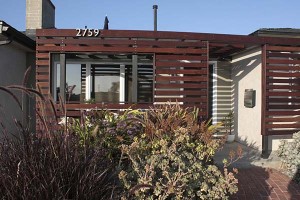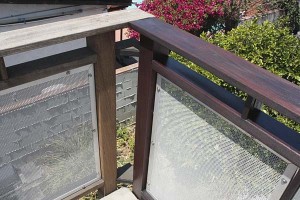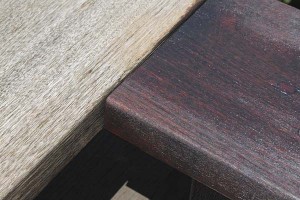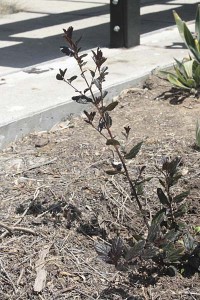The origin of Ceanothus ‘Tuxedo’ reads a bit like a horticultural soap opera: A California native species, Ceanothus thyrsiflorus, crosses the Atlantic for Europe, where it meets up with another ceanothus, this one from the East Coast of the US, Ceanothus americanus, or New Jersey tea. Loose on foreign soil the two get romantically involved, with Ceanothus ‘Autumnal Blue’ being one of the children. One of the plants of Autumnal Blue moves to Ireland, where its tolerance for moister garden conditions and good cold tolerance makes it quite popular.
(Edit, March 4, 2010: A quick trawl through David Fross and Dieter Wilken’s terrific resource, Ceanothus, reminded me that the story is even more twisted than this. The parents of ‘Autumnal Blue’ include the two species mentioned above, but also the Mexican and Guatemalan species, C. caeruleus. The plot thickens…)
There, in Ireland, growing on the grounds of Fitzgerald Nurseries, one of the branches suddenly throws a mutation, where the normally green leaves are instead a dramatic dark color, something between dark chocolate, inky black and maybe just a little grape thrown in. Pat FitzGerald notices the strikingly different branch, and begins a propagation program in earnest. His nursery lists several other near-black plants, including the dramatic Phormium cookianum ‘Black Adder.’ Eventually the plant crosses back to the other side of the Atlantic, for California, where it was released in limited distribution last year.

That’s when I met this totally unique looking ceanothus and decided I wanted it for my garden. I brought a little gallon plant and located it where I wanted a dramatic six-foot shrub, expecting that it would be a quick-growing screen plant. Almost a year later, though, the little plant remains a little plant, and hasn’t really grown. Even though I watered it all last year as you would most new plants in the garden, my guess is that I failed to give it enough water through the 146 consecutive days without measurable precipitation that San Diego experienced, the third-driest rainless time in our record books.
To the plant’s credit, it didn’t die. And now the rains have saturated the soil, it’s showing some interest in putting out some new growth. But I felt like I needed some guidance in doing a better job growing this plant. Who better to ask than the person who probably has the most experience with this plant? Why not contact Pat FitzGerald, its originator?
Thankfully, Pat was generous with his time in responding to my questions. Here are some excerpts from the advice he sent my way.
Regarding dry conditions yes I would expect slow growth. Have you prunded your plant. I noticed from the picture on your blog it had very long un-pruned branches. Like a lot of shrubs in dry conditions I think thought needs to be put into helping the plants in the first year get depth of root penetration so that during dry spells its taking moisture from a depth. I suspect if you can give moisture to Tuxedo during the first year of establishment to help it along and prune next spring you will see dense growth establish…
I highlight moisture retention as a lot of people harp on about using water and drought but often forget you can condition your soil to retain more of that valuable moisture. There are so many recycled composts to be purchased or that the householder can make now that you can work into the soil to make pockets 3 X 3 feet around newly planted shrubs or even mulch to give them that start in life. The cure to drought and slow growth in dry areas is more often what you do before you plant than after as I am sure you well know but it needs repeating and repeating to the public…
Tuxedo will behave differently depending on soil density so in heavy soil I have seen plants exhibiting a shorter more compact nature to their growth. If planted in shade and especially in a lighter soil Tuxedo will certainly stretch as it seems to much prefer full sun for sake of both colour and flowering. In our more moist climate I think the plant can get to 8 feet as can many many shrubs here in our temperate climate…
I think the one comment I would have is that simply Tuxedo is for me more than a Ceanothus with deep dark foliage. Tuxedo is an evergreen foliage plant and once established in the garden hardy to minus 12 celcius in our experience but possibly minus 15 celcius. This is an achievement for me as I cannot recommend hardly any evergreen with such dark foliage with such winter hardiness.
Tuxedo is also a good plant for training on a trellis or wall in our climate at least. There is no doubt in my mind that Tuxedo will benefit from occasional pruning but no more than once per year.
I just hope in time Tuxedo contributes some way positively to Californian gardens. While only part native its still is a nice feeling as a plant breeder to have a plant go back to its homeland and be accepted into people’s gardens.
After reviewing Pat’s advice I’ve decided to not only give the plant more water and mulch around them for added water retention through the critical first year or two after a plant is freed into the soil. If I use an organic mulch it will break down over time and enrich the soil.
A common thread you read with many California native plants is that they detest rich soil. In fact Greg Rubin of California’s Own Native Landscape Design spoke to the local native plant society of planting large numbers of short-lived colorful plants between the large structural species so that the temporary plants could “burn up” the excess nutrients in the soil, particularly in a situation where the soil was formerly a heavily-fertilized lawn. But ‘Tuxedo,’ with parents from moister parts of California and the East Coast, sounds like it would benefit from being treated differently.

For me, growing Ceanothus ‘Tuxedo’ will be a little more work and water than growing many other ceanothus would be. But I think it should be worth it. In fact, I saw more of them in the nursery again and picked up a second gallon plant. Here you see it planted as a background for the silvery foliage and eventual orange flowers of chalk-leaf dudleya, Dudleya pulverulenta, and California fuchsia, Zauschneria californica ‘Route 66.’

Wish me and the plants luck. Not every plant is perfectly adapted to your growing conditions, but a little effort can help make them thrive. And the reasons that make ‘Tuxedo’ a little trickier in the driest parts of California might make it a good candidate for moister parts of the state, or other parts of the country where ceanothus might be marginal. This year the plant is in wide circulation and should be widely available.
Ceanothus in New York or Little Rock? This might be the one.





